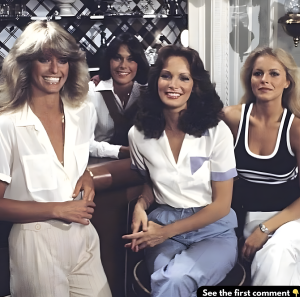
The TV Show That Redefined Female Heroes: A Look Back at “Buffy the Vampire Slayer” and Its Lasting Legacy
In the landscape of television history, few shows have had as profound an impact on the portrayal of women as Buffy the Vampire Slayer. Premiering in 1997 and running for seven groundbreaking seasons, Buffy wasn’t just a cult classic—it was a cultural milestone. At a time when female protagonists were often sidekicks, damsels in distress, or one-dimensional love interests, Buffy arrived like a stake through the heart of outdated gender tropes.
Created by Joss Whedon and led by the magnetic Sarah Michelle Gellar, Buffy the Vampire Slayer redefined what it meant to be a hero—and did so through the lens of teenage drama, gothic horror, witty banter, and deeply personal storytelling. But most importantly, it gave the world a female lead who was strong, vulnerable, intelligent, imperfect, and completely unforgettable.
The Birth of Buffy: A Slayer Unlike Any Other
Buffy Summers wasn’t your average cheerleader. She wasn’t your average girl, period. In fact, she was the Slayer—one girl in all the world chosen to fight vampires, demons, and the forces of darkness. The beauty of the premise was that it flipped every expectation: the blonde girl who usually dies first in a horror movie became the one who fights back. And wins.
Buffy was funny and flawed, deeply emotional but impossibly brave. She dealt with breakups, high school homework, the death of a parent, and literal apocalypses—all while carrying the weight of the world on her shoulders.
In many ways, she was the prototype for the modern female action hero: complicated, courageous, and never dependent on a man to define her.
More Than Buffy: A Cast of Groundbreaking Women
The brilliance of Buffy didn’t end with the title character. The show was filled with dynamic, layered female characters who were just as vital to the story.
-
Willow Rosenberg (played by Alyson Hannigan), Buffy’s best friend, transformed from a shy, nerdy schoolgirl into one of the most powerful witches on television—while also being part of one of TV’s first long-term, meaningful lesbian relationships.
-
Faith Lehane (Eliza Dushku) served as Buffy’s dark mirror—a Slayer gone rogue, showing what happens when power isn’t grounded in empathy.
-
Anya (Emma Caulfield), a former vengeance demon with a sharp tongue and no filter, brought humor and philosophical questions about humanity.
-
Even Buffy’s mother, Joyce, and younger sister Dawn, had moments that emphasized female resilience in a world that often expected women to stay quiet or supportive from the sidelines.
The female characters in Buffy weren’t just love interests or plot devices—they were the plot.
Storytelling That Didn’t Flinch
What made Buffy unique was how it seamlessly blended supernatural horror with real-world emotion. Episodes like “The Body”—which dealt with the death of Buffy’s mother in raw, unfiltered realism—showed that the show wasn’t afraid to strip away fantasy and deal with human pain.
Buffy’s struggles were metaphors for the challenges all women face: heartbreak, loneliness, pressure to succeed, fear of failure, and the burden of being everything for everyone.
And unlike many series of its time, Buffy didn’t rely on sexualizing its characters to gain viewers. Strength wasn’t measured in how much skin was shown, but in how deeply these characters loved, fought, and persevered.
A Feminist Icon, Warts and All
Buffy became a feminist icon not because she was perfect, but because she wasn’t. She struggled with self-worth. She pushed people away. She made bad choices. But she always came back stronger. She chose to fight, not because she had to, but because she believed in something bigger.
And that’s what made her—and the show—so revolutionary.
Yes, Buffy was a slayer. But she was also a sister, a friend, a lover, a student, a leader. She cried when it hurt. She laughed when it mattered. She got back up when it felt impossible.
The Cultural Ripple Effect
After Buffy, the television landscape changed. Writers, producers, and networks began taking female heroes more seriously. Shows like Veronica Mars, Alias, Orphan Black, Jessica Jones, and The 100 owe a debt to the trail blazed by Buffy Summers.
Suddenly, it became possible for women on screen to be more than just accessories. They could be the stars. They could carry complex narratives. They could save the world.
Buffy also became a staple of academic study. “Buffy studies” became a legitimate field in pop culture and gender studies, with universities offering entire courses exploring its themes, narrative techniques, and social commentary.
A Legacy Still Standing
Even more than two decades after its finale aired, Buffy the Vampire Slayer remains deeply loved and fiercely relevant. It continues to attract new generations of fans, thanks to streaming platforms, fan fiction, conventions, and ongoing discussions about representation.
Of course, the show isn’t without criticism. The legacy of creator Joss Whedon has been reevaluated in recent years, particularly as former cast members like Charisma Carpenter (Cordelia) have spoken out about alleged abuse and toxic behavior behind the scenes. This has led many to revisit Buffy with more critical eyes.
And yet, even with that complicated legacy, what endures is the impact of the characters, particularly the women. The show gave viewers a language for strength, for grief, for found family, and for the fight to be seen.
Final Word: The Girl Who Changed Everything
In the final episode, Buffy shares her power with thousands of girls around the world. “From now on, every girl in the world who might be a Slayer… will be a Slayer.” It was a perfect ending—not just for the story, but for the message: that strength is not meant to be hoarded, but shared. That every woman has the potential to be powerful, in her own way.
Buffy the Vampire Slayer redefined what it means to be a female hero—not because she had super strength, but because she led with heart. She was a warrior, a friend, a teenager, and a beacon for anyone who ever felt like the world was too much.
